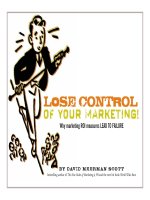Boost Your Marketing ROI with Experimental Design
Bạn đang xem bản rút gọn của tài liệu. Xem và tải ngay bản đầy đủ của tài liệu tại đây (269.77 KB, 22 trang )
Boost Your Marketing ROI with
Experimental Design
Executive Summary
CONSUMERS ARE REGULARLY BLITZED
with thousands
of marketing messages—television commercials, tele-
phone solicitations, supermarket circulars, and Internet
banner ads. Still, a lot of these messages fail to hit their
targets or elicit the desired response: the purchase of a
product or service. It has been very difficult for compa-
nies to isolate what drives consumer behavior, largely
because there are so many possible combinations of
stimuli.
In this article, consultants Eric Almquist and Gordon
Wyner explain that while marketing has always been a
creative endeavor, adopting a scientific approach to it
may actually make it easier—and more cost effective—for
companies to target the right customers. “Experimental
design” techniques, which have long been applied in
other fields, let people project the impact of many stimuli
143
HBR033ch8 1/16/02 3:11 PM Page 143
144 Almquist and Wyner
by testing just a few of them. By using mathematical for-
mulas to select and test a subset of combinations of vari-
ables, marketers can model hundreds or even thousands
of marketing messages accurately and efficiently—and
they can adjust their messages accordingly.
The authors use a fictional company, Biz Ware, to
describe how companies can map out an a grid a com-
bination of the attributes (or variables) of a marketing
message and the levels (or variations) of those attributes.
Marketers can test a few combinations of those attributes
and levels and can apply logistic regression analysis to
extrapolate the probable customer responses to all the
possible combinations. The company can then analyze
the experiment’s implications for its resources, revenues,
and profitability. The authors also present the results of
their work with Crayola, in which they used experimental
design techniques to test that company’s e-mail market-
ing campaign.
C
daily with hundreds,
perhaps thousands, of marketing messages. Delivered
through all manner of media, from television commer-
cials to telephone solicitations to supermarket circulars
to Internet banner ads, these stimuli may elicit the
desired response: The consumer clips a coupon, clicks on
a link, or adds a product to a shopping cart. But the vast
majority of marketing messages fail to hit their targets.
Obviously, it would be valuable for companies to be able
to anticipate which stimuli would prompt a response
since even a small improvement in the browse-to-buy
conversion rate can have a big impact on profitability.
But it has been very difficult to isolate what drives con-
HBR033ch8 1/16/02 3:11 PM Page 144
sumer behavior, largely because there are so many possi-
ble combinations of stimuli.
Now, however, marketers have easier access, at rela-
tively low cost, to experimental design techniques long
applied in other fields such as pharmaceutical research.
Experimental design, which quantifies the effects of
independent stimuli on behavioral responses, can help
marketing executives analyze how the various compo-
nents of a marketing campaign influence consumer
behavior. This approach is much more precise and cost
effective than traditional market testing. And when you
know how customers will respond to what you have to
offer, you can target marketing programs directly to their
needs—and boost the bottom line in the process.
Traditional Testing
The practice of testing various forms of a marketing or
advertising stimulus isn’t new. Direct marketers, in par-
ticular, have long used simple techniques such as split
mailings to compare how customers react to different
prices or promotional offers. But if they try to evaluate
more than just a couple of campaign alternatives, tradi-
tional testing techniques quickly grow prohibitively
expensive.
Consider the “test and control cell” method, which is
the basis for almost all direct mail and e-commerce
testing done today. It starts with a control cell for, say,
a base price, then adds test cells for higher and lower
prices. To test five price points, six promotions, four
banner ad colors, and three ad placements, you’d need
a control cell and 360 test cells (5 × 6 × 4 × 3 = 360).
And that’s a relatively simple case. In credit card mar-
keting, the possible combinations of brands, cobrands,
Boost Your Marketing ROI with Experimental Design 145
HBR033ch8 1/16/02 3:11 PM Page 145
annual percentage rates, teaser rates, marketing mes-
sages, and mail packaging can quickly add up to hun-
dreds of thousands of possible bundles of attributes.
Clearly, you cannot test them all.
There’s another problem with this brute force
approach: It typically does not reveal which individual
variables are causing higher (or lower) responses from
customers, since most control-cell tests reflect the com-
bined effect of more than two simple variables. Is it the
lower price that prompted the higher response? The pro-
motional deal? The new advertising message? There’s no
way to know.
The problem has been magnified recently as compa-
nies have gained the ability to change their marketing
stimuli much more quickly. Just a few years ago, chang-
ing prices and promotions on a few cans of food in the
supermarket, for example, required the time-consuming
application of sticky labels and the distribution of paper
coupons. Today, a store can adjust prices and promo-
tions electronically by simply reprogramming its check-
out scanners. The Internet has further heightened mar-
keting complexity by reducing the physical constraints
on pricing, packaging, and communications. In the
extreme, an on-line retailer could change the prices and
promotion of every product it offers every minute of the
day. It can also change the color of banner ads, the tone
of promotional messages, and the content of outbound
e-mails with relative ease.
The increasing complexity of the stimulus-response
network, as we call it, means that marketers have more
communication alternatives than ever before—and that
the portion of alternatives they actually test is growing
even smaller. But this greater complexity can also mean
146 Almquist and Wyner
HBR033ch8 1/16/02 3:11 PM Page 146
greater flexibility in your marketing programs—if you
can uncover which changes in the stimulus-response
network actually drive customer behavior. One way to do
this is through scientific experimentation.
A New Marketing Science
The science of experimental design lets people project
the impact of many stimuli by testing just a few of them.
By using mathematical formulas to select and test a sub-
set of combinations of variables that represent the com-
plexity of all the original variables, marketers can model
hundreds or even thousands of stimuli accurately and
efficiently.
This is not the same thing as an after-the-fact analysis
of consumer behavior, sometimes referred to as data min-
ing. Experimental design is distinguished by the fact that
you define and control the independent variables before
putting them into the marketplace, trying out different
kinds of stimuli on customers rather than observing them
as they have naturally occurred. Because you control the
introduction of stimuli, you can establish that differences
in response can be attributed to the stimulus in question,
such as packaging or color of a product, and not to other
factors, such as limited availability of the product. In
other words, experimental design reveals whether vari-
ables caused a certain behavior as opposed to simply
being correlated with the behavior.
While experimental design itself isn’t new, few mar-
keting executives have used the technique—either
because they haven’t understood it or because day-to-
day marketing operations have gotten in the way. But
new technologies are making experimental design more
Boost Your Marketing ROI with Experimental Design 147
HBR033ch8 1/16/02 3:11 PM Page 147
accessible, more affordable, and easier to administer.
(For more information on the genesis of this type of
testing, see “The Origins of Experimental Design” at the
end of this article) Companies today can collect detailed
customer information much more easily than ever before
and can use those data to build models that predict cus-
tomer response with greater speed and accuracy.
Today’s most popular experimental-design methods
can be adapted and customized using guidelines from
standard reference textbooks such as Statistics for Experi-
menters by George E. P. Box, J. Stuart Hunter, and William
G. Hunter; and from off-the-shelf software packages such
as the Statistical Analysis System, the primary product
of SAS Institute. A handful of companies have already
applied some form of experimental design to marketing.
They include financial firms such as Chase, Household
Finance, and Capital One, telecommunications provider
Cable & Wireless, and Internet portal America Online.
Applying experimental-design methods requires busi-
ness judgment and a degree of mathematical and statis-
tical sophistication—both of which are well within the
reach of most large corporations and many smaller orga-
nizations. The experimental design technique is particu-
larly useful for companies that have large numbers of
customers and that face rapid and constant change in
their markets and product offers. Internet retailers, for
instance, benefit greatly from experimentation because
on-line customers tend to be fickle. Attracting browsers
to a Web site and then converting them into buyers has
proved very expensive and largely ineffective. Getting it
right the first time is nearly impossible, so experimenta-
tion is critical. The rigorous and robust nature of experi-
mental design, combined with the increasing challenges
of marketing to oversaturated consumers, will make
148 Almquist and Wyner
HBR033ch8 1/16/02 3:11 PM Page 148
widespread adoption of this new marketing science only
a matter of time in most industries.
The ABCs of Experimental Design
To illustrate how experimental design works, let’s con-
sider the following simple case. A company, which we’ll
call Biz Ware, is marketing a software product to other
companies. Before launching a national campaign, Biz
Ware wants to test three different variables, or attributes,
of a sales message for the product: price, message, and
promotion. Each of the three attributes can have a num-
ber of variations, or levels. Suppose the three attributes
and their various levels are as shown in “Attributes and
Levels of a Sales Message.”
The total number of possible combinations can be
determined by multiplying the number of levels of each
attribute. The three attributes Biz Ware wants to test
yield a total of 16 possible combinations since 4 × 2 × 2 =
16. All 16 combinations can be mapped in the cells of
a simple chart like “Biz Ware’s Universe of Possible
Combinations.”
It’s not necessary to test them all. Instead, using
what’s called a fractional factorial design, Biz Ware
selects a subset of eight combinations to test.
“Factorial” means Biz Ware “crosses” each attribute
(price, promotion, and message) with each of the others
in gridlike fashion, as in the universe chart above. “Frac-
tional” means Biz Ware then chooses a subset of those
combinations in which the attributes are independent
(either totally or partially) of each other. The following
chart shows the resulting experimental design, with Xs
marking the cells to be tested. Note that each level of
each attribute is paired in at least one instance with each
Boost Your Marketing ROI with Experimental Design 149
HBR033ch8 1/16/02 3:11 PM Page 149
level of the other attributes. So, for example, price at
$150 is matched at some point with each promotion and
each message. This makes it possible to unambiguously
separate the influence of each variable on customer
response. (See “Biz Ware’s Experimental Design.”)
The eight chosen combinations are now tested, using
one of several media: scripts at a call center, banner ads
on Biz Ware’s Web site, e-mail messages to prospective
customers, and direct mail solicitations. (In general, you
should test using the medium you ultimately expect to
use for your marketing campaign, although you can also
choose multiple media and treat the choice of media as
an attribute in the experiment.)
150 Almquist and Wyner
Attributes and Levels of a Sales Message
PRICE
Level
$150 $160 $170 $180
MESSAGE
(1) Speed
“Biz Ware lets you manage customer relationships in just minutes a day.”
(2) Power
“Biz Ware can be expanded to handle a virtually infinite number of cus-
tomer files.”
PROMOTION
(1) 30-Day Trial
“You can try Biz Ware now for 30 days at no risk.”
(2) Free Gift
“Buy Biz Ware now and receive our contact manager software absolutely
free.”
(1) (2) (3) (4)
HBR033ch8 1/16/02 3:11 PM Page 150









